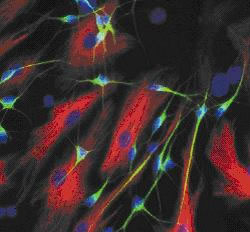Researchers this week have discovered a key step in the way in which nerve cells regenerate, which they hope they could use to speed up the process.
Nerves of the spinal cord sadly don't regenerate but the peripheral nerves that connect  arms, legs and organs to the central nervous system can repair themselves following an injury. Publishing in the journal Cell this week, researchers have identified cells called fibroblasts which are essential in making this happen.
arms, legs and organs to the central nervous system can repair themselves following an injury. Publishing in the journal Cell this week, researchers have identified cells called fibroblasts which are essential in making this happen.
Peripheral nerves are singular in the cell world because they are so very long. They have a nucleus in the spinal cord and the axons that extend from them and relay nerve messages can reach all the way down a leg. So when a nerve is cut, all the axons further toward the end of the limb will degenerate. In order for them to be repaired the two loose ends must find each other.
Alison Lloyd and colleagues from University College London already knew that Schwann cells were important in connecting these loose ends. These cells normally sit quietly around the axons and are only kicked into life when damage occurs, at which point they become similar to stem cells and rejoin the nerves.
But these Schwann cells can't act alone. Lloyd and colleagues have discovered that in the sciatic nerves of rats, an already well-known cell type gives a helping hand: the fibroblast.
The fibroblasts communicate with the Schwann cells using the so-called 'ephrin-B' signal, which makes them clump, or line up together. They then start to travel outwards from the nerve stump as a group. These lines of Schwann cells then guide the regrowth of axons across the wound.
Lloyd hopes that this discovery might lead to ways to improve the repair of peripheral nerves as, although they are able to repair themselves naturally, quite often the process is slow and patchy.










Comments
Add a comment